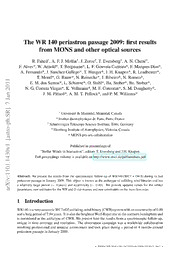
The WR 140 periastron passage 2009: first results from MONS and other optical sources PDF
Preview The WR 140 periastron passage 2009: first results from MONS and other optical sources
The WR 140 periastron passage 2009: first results from MONS and other optical sources R. Fahed1, A. F. J. Moffat1, J. Zorec2, T. Eversberg3, A. N. Chene´4, F. Alves*, W. Arnold*, T. Bergmann*, L. F. Gouveia Carreira*, F. Marques Dias*, A. Fernando*, J. Sanchez Gallego*, T. Hunger*, J. H. Knapen*, R. Leadbeater*, T. Morel*, G. Rauw*, N. Reinecke*, J. Ribeiro*, N. Romeo*, 1 1 E. M. dos Santos*, L. Schanne*, O. Stahl*, Ba. Stober*, Be. Stober*, 0 N. G. Correia Viegas*, K. Vollmann*, M. F. Corcoran*, S. M. Dougherty*, 2 n J. M. Pittard*, A. M. T. Pollock*, and P. M. Williams* a J 7 ] R 1 Universite´ deMontre´al,Montre´al,Canada S . 2 InstitutdastrophysiquedeParis,Paris,France h p 3 Schno¨rringenTelescopeScienceInstitute,Ko¨ln,Germany - o 4 HerzbergInstituteofAstrophysics,Victoria,Canada r t s *MONSpro-amcollaboration a [ 1 Publishedinproceedingsof v 0 ”StellarWindsinInteraction”,editorsT.EversbergandJ.H.Knapen. 3 4 Fullproceedingsvolumeisavailableonhttp://www.stsci.de/pdf/arrabida.pdf 1 . 1 0 1 1 : Abstract: We present the results from the spectroscopic follow-up of WR140 (WC7 + O4-5) during its last v i periastron passage in January 2009. This object is known as the archetype of colliding wind binaries and has X a relatively large period (∼ 8years) and eccentricity (∼ 0.89). We provide updated values for the orbital r a parameters,newestimatesfortheWRandOstarmassesandnewconstraintsonthemass-lossrates. 1 Introduction WR140isaveryeccentricWC7+O5colliding-windbinary(CWB)systemwithaneccentricityof0.89 andalongperiodof7.94years. ItisalsothebrightestWolf-Rayetstarinthenorthernhemisphereand is considered as the archetype of CWB. We present here the results from a spectroscopic follow-up, unique in time coverage and resolution. The observation campaign was a worldwide collaboration involving professional and amateur astronomers and took place during a period of 4 months around periastronpassageinJanuary2009. Workshop“StellarWindsinInteraction”ConventodaArra´bida,2010May29-June2 Table1: Listofthedifferentsourcesinthe2009campaign. Observatory Dates WavelengthRange(A˚) Resolution(A˚/pixel) Numberofspectra Tenerife 1.12.08-23.03.09 5530-6000 0.35 34 OHP 12.12.08-23.3.09 4000-6800 0.01 63 DAO 22.4.08-9.1.09 5350-5900 0.37 13 OMM 5.7.09-8.8.09 4500-6000 0.63 18 RobinLeadbeater 10.12.07-20.3.09 5600-6000 0.68 38 BertholdStober 26.8.08-29.2.09 5500-6100 0.53 12 2 Observations Amongtheamateurdata,wefirsthavetheMONSproject: undertheleadershipofThomasEversberg, aGermanamateurastronomerwhohasfoundedhisownastronomicalobservatory(theSchno¨rringen Telescope Science Institute), a LHIRES spectrograph was installed on a telescope now owned by the Instituto de Astrof´ısica de Canarias (IAC), but previously by the University of Mons (Belgium) and which is used mainly for pedagogical purposes. The 50cm telescope is located at the Teide observatoryoftheIACinTenerife. Duringfourmonths,datahavebeenacquiredwiththisinstrument. OtheramateurscontributedusingtheirownpersonalinstrumentsinPortugal,GermanyandEngland. TheprofessionaldatawereobtainedwiththeechellespectrographSOPHIEattheObservatoirede Haute Provence (OHP), at the Dominion Astrophysical Observatory (DAO) and at the Observatoire duMontMe´gantic(OMM).Alistofthedatasourcesandcharacteristicsofthecampaignispresented Table1. 3 Radial velocities The WR star radial velocities were measured by cross correlation with a reference spectrum and the O star radial velocities by measuring the centroid of the photospheric absorption lines (see Fig. 1). Wenotablyfindahighereccentricitythanpreviouslypublished(e = 0.896±0.002cf. 0.881±0.005 from Marchenko et al. 2003 = M03) and update the value for the period (2896.5 ± 0.7d instead of 2899.0±1.3d). 4 Excess emission The presence of a shock cone around the O star induces an excess emission that we measured on the CIII 5696 flat-top line. This excess emission appears first, just before periastron passage, on the blue side of the line, and then moves quickly to the red side, just after periastron passage, before it disappears (Fig. 2). We fitted the radial velocity and the width of this excess as a function of orbital phase using a simple geometric model (Luehrs 1997) taking into account the half opening angle of theshockconeθ,thevelocityofthefluidalongtheconev ,theorbitalinclinationiandanangular strm shift due to Coriolis forces δφ (see Fig. 3). The result of this fit is shown in Fig. 4. We find a value for the inclination of 52◦±8◦ (cf. 58◦±5◦ from Dougherty et al. 2005), which yields the following estimateforthestellarmasses: M =18.4±1.8M andM =45.1±4.4M (cf. 19M and50M WR (cid:12) O (cid:12) (cid:12) (cid:12) from M03). From the half opening angle of the shock cone (Canto et al. 1996), we also find a wind momentumratioη =0.028±0.009. 14 Figure 1: (Top two panels) Measured radial velocities of the WR star and of the O star together with the fit for the orbital solution (full line). We included data from the last periastron campaign in 2001 (M03). The black dashed line is the orbital solution from M03. The dashed vertical lines show the position of the periastron passage. (Bottom two panels) Same plots but zoomed in on the 2009 campaign. Thebestfitparametersareindicatedingrey. 15 Figure2: (Left)TheCIII 5696flattoplineasafunctionoftheorbitalphase. (Right)Excessemission asafunctionofthephase,obtainedbysubstractionofareferenceprofile,unaffectedbywindcollision. Figure3: SchematicviewofthegeometricmodelbyLuehrs(1997). Thefullwidthandradialvelocity (cid:113) of the excess will then be given by : FW = C + 2v sin(θ) 1−sin2(i)cos2(φ−δφ) and ex 1 strm RV = C −v cos(θ)sin(i)cos(φ−δφ) ex 2 strm 16 Figure 5: Normalized flux of the excess as a function of the rela- tive separation of the two stars ( [d − d ]/d ). The full line min min Figure 4: Fit of the radial velocity and width of the excess shows a d−1 dependancy, expected using the Luehrs (1997) model (full grey line). The black for an adiabatic emission process. dashedlineshowsthesolutionfromM03. Thedashedlineshowsad−2 depen- dency,possiblymoreinlinewithan isothermalprocess. 5 Conclusion The 2009 periastron campaign on WR140 provided updated values for the orbital parameters, new estimates for the WR and O star masses and new constraints on the mass-loss rates. However, our capability to measure the shock cone parameters with confidence and to understand its underlying physics is limited by the over simplistic approach of our model. A more sophisticated theoretical in- vestigation should be done. Meanwhile, the d−2 dependency of the excess, shown in Fig. 5, strongly suggests that some kind of isothermal process is involved here. Links with observations in other spectral domains (X-ray, infrared, and radio) will certainly provide valuable clues about the physics. Finally, we will attempt to isolate the WR spectrum from the O-star spectrum from our data in or- der to identify the spectral type of the latter more precisely. We also have some photometric and spectropolarimetricdatatoanalysetocompleteourviewofthissystem. References Canto,J.,Raga,A.C.&Wilkin,F.P.,1996,ApJ,469,729 Dougherty,S.M.,Beasley,A.J.,Claussen,M.J.,Zauderer,B.A.&Bolingbroke,N.J.,2005,ApJ,623,447459. Luehrs,S.,1997,PASP,109,504513. Marchenko, S.V., Moffat, A.F.J., Ballereau, D., Chauville, J., Zorec, J., Hill, G.M., Annuk, K., Corral, L.J., Demers, H., Eenens, P.R.J., Panov, K.P., Seggewiss, W., Thomson, J.R. & Villar-Sbaffi, A., 2003, ApJ, 596,12951304. 17 18
